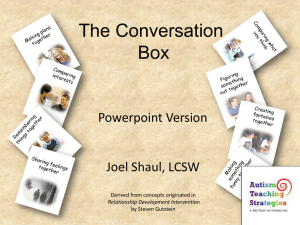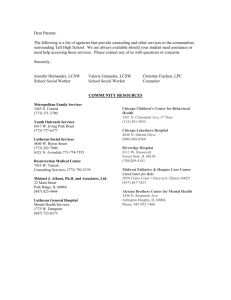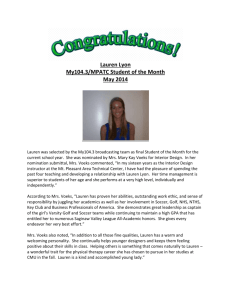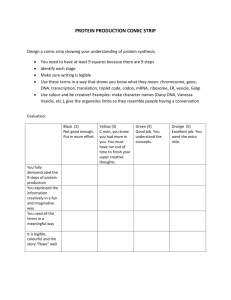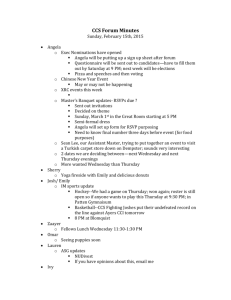building effective interventions for children and adolescents
advertisement
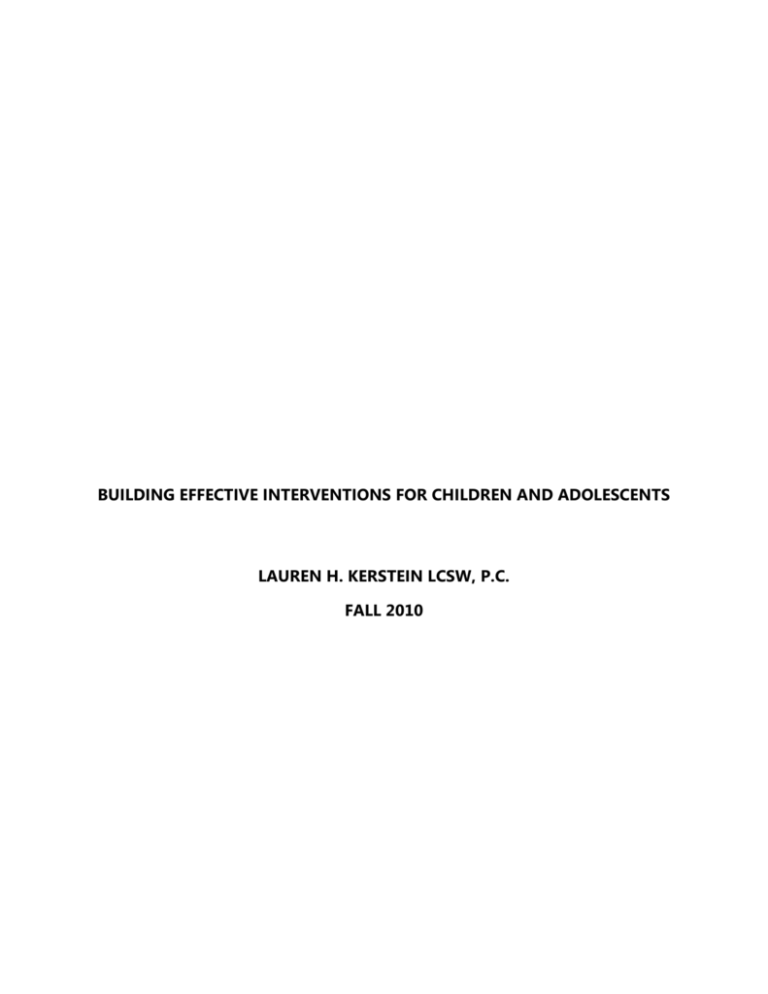
BUILDING EFFECTIVE INTERVENTIONS FOR CHILDREN AND ADOLESCENTS LAUREN H. KERSTEIN LCSW, P.C. FALL 2010 TABLE OF CONTENTS GATHERING INFORMATION KEY DEVELOPMENTAL CONCEPTS LEARNING SELF-REGULATION IN CONFLICT MANAGEMENT ATTENTION TO TASK LENGTH OF INTERVENTION NEEDED “BEHAVIORAL” STRATEGIES PROACTIVE STRATEGIES Schedules Social Stories™ Comic Strip Conversations Reinforcements Increasing a Parent’s Toolbox Underlying Issues REACTIVE STRATEGIES Response Cost Reverse Time-Out Planned Ignoring FEELING AWARENESS AND REGULATION IDEAS FOR DEVELOPING AN UNDERSTANDING OF FEELINGS IN SELF AND OTHERS Children’s Books Magazines Television Comic Strip Conversations and Social Stories™ Mirror Faces Puppet or Doll Play Role Play IDEAS FOR DEVELOPING AN UNDERSTANDING OF TRIGGERS © Lauren H. Kerstein LCSW, P.C., 2010 Copies of this packet will be distributed for training purposes and will not be sold for profit. IDEAS FOR DEVELOPING AN UNDERSTANDING OF INTENSITY TAKING THE TEMPERATURE PLAN A OR PLAN B SUMMARY RESOURCES © Lauren H. Kerstein LCSW, P.C., 2010 Copies of this packet will be distributed for training purposes and will not be sold for profit. © Lauren H. Kerstein LCSW, P.C., 2010 Copies of this packet will be distributed for training purposes and will not be sold for profit. Gathering Information When we work with families, we typically have multiple ways to gather information. These sources of information include, but are not limited to: written documents such as Individualized Family Support Plans (IFSP’s), Individualized Education Plans (IEP’s); verbal conversations with other providers; and written and verbal information from the referral source. These bodies of information play a critical role in effectively assisting children and families. The information we gather independent of written documents is critical as well. In planning and providing effective interventions, we need to ensure we have explored all aspects of a child. The knowledge we strive to gain needs to incorporate the system in which the child lives. If we do not take systems issues and all aspects of a child into consideration, our interventions will not be as successful as we wish. Table 1 provides a tool one might use in order to think more globally about a child and the system in which he/she lives. Table 1: What Else Do You Need to Know or Do You Already Know? What Else Do You Need to Know or Do You Already Know? Background Issues Information Assumption Intervention Medical Mental Health Sleep Eating Culture Other Diagnoses Lauren H. Kerstein LCSW, P.C. 2010 5 Assumptions are easy to make in our field. For example, perhaps we read an IFSP that describes a child who is exhibiting “aggressive behaviors”. It might be very easy to © Lauren H. Kerstein LCSW, P.C., 2010 Copies of this packet will be distributed for training purposes and will not be sold for profit. think behaviorally—“what interventions to we need to put into place from a behavioral perspective that would diminish or ideally extinguish this behavior?” It might also be easy to think sensory—“this child is acting out to obtain sensory information and must be struggling with sensory integration issues”. It is possible that each of these hypotheses in isolation might be sound and provide us with an intervention path that is effective. It might also be possible, however, that each of these hypotheses in isolation miss the path entirely. Perhaps this child is suffering with an undiagnosed medical issue and is uncomfortable. Feeling uncomfortable can certainly increase a child’s challenges with regulation and cause aggressive and acting out behaviors. It is critical, that providers explore each and every detail of a child from medical conditions and medications to mental health, sleeping and eating. Additionally, a child’s journey through developmental milestones can also impact behavior. A child who is attempting to master toilet training and (as is common) becomes a bit constipated, might be in enough discomfort to begin acting out. Finally, the cultural background of a child can play a large role in the ways in which families are addressing or responding to needs and strengths of the child. In addition to gathering the information described in Table 1, it can also be quite useful to gather as much information as possible about the interventions the family has tried already. The trick to asking these questions in a successful manner is to take a “thermometer reading” in the home. Is the family hesitant or vigilant around your involvement and needs you to gain their trust before jumping in? Does this family have a history of being accurate reporters? Are some of the questions inappropriate to ask in front of the child? How might you approach some of these questions in a therapeutic, supportive way? Once you have assessed the family dynamics, you can begin to gather information. This information gathering may take a number of sessions to attain although much of it can be included in your initial intake. Let’s say, for example, that you are trying to determine what consequences the family has tried for the negatively described behavior. The sequence of your questions may look as follows (please note that although these are not listed in a question and answer format—it is typically most effectively to incorporate these into a conversation rather than as a questionnaire. It is also helpful to alert caregivers that you will need to ask a number of questions today, at intake, in order to make sure you have the information you need to progress with interventions: © Lauren H. Kerstein LCSW, P.C., 2010 Copies of this packet will be distributed for training purposes and will not be sold for profit. Table 2: Gathering Information In More Depth Describe the behavior. If I were there when the behavior occurred, what would I see your child do? What would I see you do (cry, laugh, yell, walk away)? Does this behavior occur at particular times of the day? How often is the behavior occurring each day? Rate the intensity of the behavior on a 0 to 5 scale with 5 being the most intense. Is it this intensity each time or does it vary? How long does the behavior last (each incident)? Have you seen any clear triggers? Do you see a relationship between fatigue and behavior? Do you see a relationship between hunger and behavior? What consequences have you tried? What did the consequence look like (if I were there, what would I have seen?) How long did you try that particular consequence for (days, weeks)? Did you try it the same way each time? How did your child react to the consequence? Do you think the consequence has decreased the behavior? It might also be helpful to gather information about how a parent or caregiver communicates success to a child. If your child has done a good job or made a good choice, how do you communicate this to your child? How do you communicate your expectations to your child? © Lauren H. Kerstein LCSW, P.C., 2010 Copies of this packet will be distributed for training purposes and will not be sold for profit. It is important to recognize that interventions may look quite different within this particular family system than you’re envisioning. When a parent says they have tried time out, for example, and it doesn’t work, that may be true. It may also be that their particular method of time out doesn’t work and another method of taking a break or time out might work better. Asking the above questions will add clarity as you determine a new set of interventions. Key Developmental Concepts As we develop goals and interventions, it is critical that we examine developmental information so that we can ensure we are basing our expectations, goals and interventions on a solid developmental foundation. Learning I once heard it stated that it takes about 75 repetitions to learn an academic skill. I might be hard-pressed to find exact statistics in the literature, but suffice it to say that repetition has been found to have great value in many different modes of learning (Conkling, 2001). I take that arbitrary number of 75 and double it for behavior. When we are working toward intervening within the behavior paradigm, we are in essence, reconstructing behavior. We are extinguishing the old (potentially effective in the eyes of a child) behavior and replacing it with a new more effective and more adaptive behavior. This is not an easy job. It is critical, then, that we choose our interventions wisely and then put them in place for at least 3 weeks in order to ensure that the strategy is effective. The intervention must be as consistent as possible in order to provide repetition and time for skill building. Responding in an adaptive way to life’s challenges is a skill—a skill that children are not necessarily born with innately. The literature states that children often choose actions over words in stressful situations (hitting, pushing, etc.) until they are close to five and six years of age. This example certainly supports the idea that adaptive responses are a skill not necessarily an innate part of temperament and knowledge. In addition to the concept of repetitions in learning, it is important to take learning style into consideration. Many children benefit from visual strategies that are paired with auditory or movement opportunities during teaching tasks. Interventions will be most effective if different learning styles are incorporated. For example, a child may benefit from practicing expressive language while swinging on a swing. Another child might require a visual picture schedule so that the child can see the periods of time in which teaching will occur versus the periods of time in which he/she can take a break. Self- Regulation in Conflict Management © Lauren H. Kerstein LCSW, P.C., 2010 Copies of this packet will be distributed for training purposes and will not be sold for profit. Caregivers are often looking to us both as a developmental reference as well as an interventionist. One of the gifts we can give families is to assist them with sorting out “typical” development from development that crosses the proverbial developmental line. The proverbial line is not easy to draw, however. One such difficult “line” is the line between challenges with self-regulation and conflict management and concerning aggression. The Centers for Disease Control and Prevention (CDC’s) lists “negotiates solutions to conflicts” as a skill that is expected in the latter part of the four year old year of development (http://www.cdc.gov/ncbddd/actearly/milestones/milestones4yr.html). The HELP for Preschoolers (1995 Vort Corporation) and the Child Development Inventory (Ireton, 1995) also highlight the use of words versus actions as a milestone more likely to be exhibited in 5 year olds versus younger children. It is thus developmentally appropriate to see children “act out” or even exhibit some aggression in the midst of conflicts. The work we do must provide support for how to begin to develop the ability to respond to conflict in a more adaptive way. These strategies will be discussed in the proactive and reactive sections of this text. Tables 3 and 4 reflect children’s development and typical parental reactions. These reactions are the reactions of concerned parents who want the best for their child. Our task is to assist parents with understanding typical development; support them in developing more effective responses; and teach them how they can increase children’s acquisition of the skills they need. Table 3-- Sorting Out “Typical” Development and Behavior—Birth to Three Sorting out “Typical” Development and Behavior– Birth to Three Developmental Milestone Response of the Child Response of the Parent Fear toward unfamiliar people • Clinginess with familiar person • Separation Anxiety •Frustration •Anxiety •Fear to leave child •Desperation (“I need to be able to get away.”) Desire for independence •“No” •Negativism •Glowering •Take the negativity personally •Child is being purposefully defiant •Punish •Frustration •Becomes more difficult to go out in public Temper Tantrums Screaming Kicking Hitting Crying •“I’m doing something wrong.” •“I can’t go to the store Lauren H. anymore”. Kerstein LCSW, P.C. 2010 11 © Lauren H. Kerstein LCSW, P.C., 2010 Copies of this packet will be distributed for training purposes and will not be sold for profit. © Lauren H. Kerstein LCSW, P.C., 2010 Copies of this packet will be distributed for training purposes and will not be sold for profit. Table 4-- Sorting Out “Typical” Development and Behavior—Birth to Three Continued Sorting out “Typical” Development and Behavior– Birth to Three Developmental Milestone Response of the Child Response of the Parent Toilet Training •Exert Control •Fear •Withholding •Increased Tantrums •Worry over accidents •Constipation •Feels pressure •Frustrated •Out of control •Unsure Biting, Hitting, Scratching, Spitting, Throwing •“If I do this. . . What will happen?” •“HELP, I’M ON OVERLOAD!” •Lose control (which can frighten and reinforce behavior) •Feel like their child is the only one •Feel helpless •Frustrated •Angry Lauren H. Kerstein LCSW, P.C. 2010 13 Attention to Task Years ago, I attended a conference in which the keynote speaker stated that the average adult brain can attend to information for ten minutes before they start to drift. Other readings have stated adults remained attentive for 20 minutes. Many writers refer to a study conducted by Ralph A. Burns (1985) in which he discussed the decrease in attention span during 15-20 minute intervals of speaking. This concept lodged in my brain and has really impacted the way in which I practice. It would seem that if adults have about 10 minutes before they drift, children have about. . . well. . . not very much sustained attention. We have all seen children attend to tasks that are high interest for long periods of time, but often this does not translate to tasks that are low interest, difficult or simply not “on their agenda”. Schmitt (1991) states that children can sustain attention for 3 to 5 minutes per year of age. A two-year old, for example, should be able to sustain attention for 6 minutes. This however can vary depending on task, other developmental challenges, environmental stimuli, etc. It is critical, then for us to adjust our sessions to include strategies that facilitate sustained attention. The can include, but are not limited to breaks, clear (possible visual) shifts from one task to another, sensory input, and clear beginning, middle and ends of tasks. © Lauren H. Kerstein LCSW, P.C., 2010 Copies of this packet will be distributed for training purposes and will not be sold for profit. There are a number of ways to assist a child with increasing his/her attention span. Table 5 lists some strategies for attention. Table 5: Increasing Attention Span in Children Strategy Use a timer Create a quiet, non-distracting space Praise Reading to the child Description It is helpful to use a timer to teach children to increase their attention to task. You can begin with small intervals and then slowly increase the amount of time on the timer. You might make it a game—“we are going to work on this puzzle until the buzzer goes off. I think we can do it!” Or you can say, “let’s see how long it takes for us to finish this puzzle” and then challenge the child to do another puzzle after you time the first one. It is important to tailor all strategies to the developmental level of the child in terms of language use and comprehension. Homes and childcare environments are often filled with distractions. These distractions serve as attention-busters. It is critical to create quiet spaces in which children can work with minimal distractions. This will assist children in becoming fully engaged and expanding their attention. Praising a child and pointing out times they are sitting and attending can also facilitate an increase in attention span. It is important to know your child—if you will disrupt her attention by praising at that moment, then hold your praise until the child is finished. You can then tell the child what a good job they did sitting and concentrating on the task. Again, tailor your praise to your child’s expressive and receptive language ability. It is also critical to make your praise specific and highlight the particular accomplishment of the child. Reading to children can increase their attention span. The reading can include traditional reading or can incorporate a discussion about pictures, themes, observations, etc. © Lauren H. Kerstein LCSW, P.C., 2010 Copies of this packet will be distributed for training purposes and will not be sold for profit. Set up engaging craft activities Teach your child how to play with toys in new and different ways Monitor television exposure Engage children in everyday activities Creating a craft space and activity for a child can facilitate a longer attention span. It often helps if the adult demonstrates how to use the tools. Teaching children variations in play can increase their ability to sit and focus on a particular play task. Many children do not know how to shift from building a block tower to pretend play with the blocks to building a zoo and having the animals march in. Adults can teach children the many variations and functions of toys. Early television exposure has been found to have a negative impact on attention span (Christakis, Zimmerman, DiGiuseppe, & McCarty, 2004). Shopping “list” It may be useful to encourage caregivers to look at attention span as a skill. Adults often have to assist children with increasing their attention to task in order to meet the demands of their world at home and school. Length of Intervention Needed As will be discussed later, intervention strategies need to be consistently in place for at least 3-4 weeks in order to see behavior change. It is critical that families understand the length of time needed in order to assess whether a particular strategy is effective. Families will need support trying strategies for this extended period of time. Families also need to understand that behaviors can often peak or get worse before they get better. Children will typically increase their testing behaviors in order to see if their parent or caregivers will “give in”. “Behavioral” Strategies Parents are often looking to their providers to provide the magic words or strategies that will extinguish “behavior” forever. Unfortunately, however, there is no magic bullet in terms of addressing behavior. It is important for parents to know that although you may be able to put some strategies in place that decrease behavior, the key to behavior reduction is two-fold: Putting a lot of proactive strategies in place, and being ready to change strategies (such as reinforcement systems) in order to prevent satiation. © Lauren H. Kerstein LCSW, P.C., 2010 Copies of this packet will be distributed for training purposes and will not be sold for profit. Proactive Strategies Table 6 lists proactive strategies that may be helpful when working with children and adolescents. Many of the strategies listed are self-explanatory. Others, however, require some explanation. You will find a description of some of these strategies below the chart. Table 6: Proactive Strategies Proactive Strategies 1. Schedules 2. Social Stories 3. Comic Strip Conversations 4. Reinforcements 5. If. . . Then 6. Traveling Toolbox 7. Grocery Store Check-list 8. Teach Skills 9. Feeling awareness 10. Sensory 11. Communication 12. Social 13. Set realistic goals 14. Set clear expectations 15. Reminders of rules 16. Hugs, snuggles, special time 17. Make things predictable 18. Use Visual Supports! Schedules The use of schedules has been shown to be a very useful way to assist children. Schedules create a sense of predictability and consistency. This can reduce anxiety in children and assist them with flexibility. Schedules can incorporate pictures, words or both and can be used for just about any activity or event. Schedules can also facilitate the development of “if. . . then” which is an important cause and effect concept for children. “If you brush your teeth, then we can play a game.” Social Stories™ Social Stories™ were introduced by Carol Gray (1993, 1994, 2000). Social Stories™ are a tool to describe expectations, rules and social norms. Social Stories™ are © Lauren H. Kerstein LCSW, P.C., 2010 Copies of this packet will be distributed for training purposes and will not be sold for profit. typically associated with children on the autism spectrum but can actually be a useful tool for many children regardless of diagnosis or development. The key to using social stories is to match the verbiage with the developmental ability of the child. Carol Gray recommends a particular format in order to be most effective. I have found that social stories can also be effective outside of that format. Social Stories™ can be used to teach just about anything from brushing teeth to toilet training to voice volume. The following sample story is not written in the format in which Gray recommends but provides an example of how to write a story. Holding Hands I hold mommy’s hand. I hold Daddy’s hand. I stop. I hold hands. I am safe. A Social Story™ is most useful when read many times, during both neutral times and in preparation for times that may be challenging. Clipart pictures can be used as well as real pictures (of the child). For some children, real pictures with recognizable people, places and things can often be more effective. © Lauren H. Kerstein LCSW, P.C., 2010 Copies of this packet will be distributed for training purposes and will not be sold for profit. Comic Strip Conversations Comic Strip Conversations were also developed by Carol Gray (1994). The function of a comic strip conversation is to provide an instructional technique whereby a child might begin to develop an understanding of cause and effect and more effective communication skills. Comic Strip Conversations are highly visual in nature which is thought to facilitate learning. Gray (1994) offers a guide to the development of symbols and communication devices within the Comic Strip Conversation. The use of Comic Strip Conversation can also be very effective in reducing behaviors. The following is an example of how to use a comic strip conversation. Please know that stick figures are a perfectly effective way to utilize this method of intervention. Comic Strip Conversations become much more helpful when used “in the moment.” Cartoon 1 “When you ran through the kitchen, you knocked over your baby brother. He is sad.” Cartoon 2 You can then draw a second cartoon to show the behavior or actions that would’ve been most helpful. “You walked slow as a turtle and your brother is happy.” Comic Strip Conversations, Social Stories™ and schedules are three examples of helpful visual strategies that can support a child and family. © Lauren H. Kerstein LCSW, P.C., 2010 Copies of this packet will be distributed for training purposes and will not be sold for profit. Reinforcements There are many ways to develop a system of reinforcement. There are a few key points to consider when devising a system. Make sure you put reinforcements in place that are meaningful to the child. Make sure you create systems that are realistic for the family. Clearly identify the behaviors you are trying to reinforce. Incorporate the goals of the family into the reinforcement system by identifying one or two specific areas that will be impacted by this system. Establish the ways in which the reinforcement will take place. Identify the expected obstacles. Variable reinforcement is the most powerful way to reinforce. If we think about a person playing the slot machines—if that person receives a few quarters intermittently, that person is more likely to continue playing. This concept of reinforcement is also true for negative reinforcement. Given the unnerving fact that one of children’s jobs is to test, we must prepare our parents for the variable reinforcement pitfall. If a parent “gives in” once, the testing will be strengthened thereby increasing behavior for a period. Once a parent is consistent in setting limits (for a period of time which varies depending upon the child), the child will more than likely cease testing (in that particular area). Increasing a Parent’s Toolbox It is critical to describe, model, and write different interventions a parent can use. These descriptions must be applicable to home and community. Parents often find strategies that make behavior a bit more manageable at home but then dread going out into the community. It is our job as provider to introduce strategies that will work in the community as well as at home. One such strategy is a grocery shopping list. The parent can cut a small piece of a box or a bag of finished food. These pieces can be stapled or hole-punched and connected. These labels can then serve as the child’s shopping list. The child can hold the “list” and help his/her parent find the items in the store. This supports a lot of nice cognitive skills as well as serving as a helpful behavior strategy. Underlying Issues It is natural and easy to label areas of challenge as behaviors. The pitfall with this label is that we lose sight of the potential underlying issues that led to the behavior. Figure 1 shows the possible relationship between skills areas and aggression. © Lauren H. Kerstein LCSW, P.C., 2010 Copies of this packet will be distributed for training purposes and will not be sold for profit. Figure 1: Linking Skills to Behaviors Linking Skills to Behaviors Theory of Mind Sensory Processing Mental Health/Anxiety Aggression Social Problem Solving Executive Function Social Interaction Lauren H. Kerstein LCSW, P.C. 2010 7 It is critical that we put interventions in place that address any underlying core deficit in a child while simultaneously building upon strengths. These underlying challenges can include but are not limited to: sensory issues, feeling awareness, social interactions, problem solving, theory of mind and executive function. Please see the reference list below for some resources that might help you design interventions that address these varying challenges. Reactive Strategies It is, of course, the hope that proactive strategies will prevent all behavior. It is not, however, the reality. This fact is very frustrating and warrants us to be prepared with strategies in reaction to any “behavioral” challenges that may arise. Table 7 provides an overview of some of the strategies that can be helpful after the “behavior” has occurred. © Lauren H. Kerstein LCSW, P.C., 2010 Copies of this packet will be distributed for training purposes and will not be sold for profit. Table 7: Reactive Strategies Reactive Take a break Time Out Reverse Time Out Response Cost Social Stories Comic Strip Conversations Removal from area Planned Ignoring Gently holding the child and helping the child calm down Regardless of the behavior, reactive strategies are meant to set limits and be teaching tools. The definition of discipline includes the word instruction. If we don’t teach a child what we do want in the midst of them acting in ways we don’t want, we won’t be successful in ultimately reducing the behavior. Many of the interventions listed above have been previously explained since interventions used proactively can also be useful reactively. The following is a description of some of the other reactive interventions that can be used. Response Cost Response Cost is the removal of an item, a privilege or attention as a consequence for negative behavior. The benefits of using this method of intervention are twofold: behavior can often be reduced using this strategy and it is easier to remove an item, privilege or attention than a child. It is often most effective to time-limit the removal so that the child doesn’t lose interest in the object. For example, if a child throws a toy, the toy can be placed in time out for 2 minutes. This also gives the child a chance to “correct” his/her behavior. Reverse Time-Out Reverse time-out is similar in concept to response cost. The caregiver can remove him/herself for a small time-out instead of the child. This removal might look like moving to a different spot in the room or a different room entirely. A reverse time-out is typically a short-lived (anywhere from 10 seconds to 1 minute per age of child). The message of a reverse time-out is, “I need to walk away if you are hitting. When you are gentle (calm, moving more slowly), I can come back. © Lauren H. Kerstein LCSW, P.C., 2010 Copies of this packet will be distributed for training purposes and will not be sold for profit. Planned Ignoring Planned ignoring is designed to remove reinforcement from negative behaviors. Planned ignoring is typically put into place if a functional analysis identifies attention as the function of a particular behavior. If a child begins spitting in anger, a parent can purposefully ignore the behavior. Children will often “up the ante” if a behavior is ignored thereby putting the parent in a position of enacting planned ignoring for a series of behaviors rather than just one behavior. It is often helpful to pair planned ignoring with a behavioral concept called differential reinforcement of other (DRO). DRO is a method of reinforcing preferred behavior and ignoring nonpreferred behavior. DRO has been shown to be effective in the reduction of a number of behaviors including selfinjurious behavior and noncompliance. The criticism of DRO is the time commitment in terms of data collection (Gongola and Daddario, 2010). Despite this criticism, however, DRO can be a powerful way of supporting positive behavior over negative behavior. Feeling Awareness and Regulation Professionals and families often assume that children will develop the ability to understand and manage their feelings somewhat intuitively. In reality, however, although children may be acutely aware of changes in the emotional temperature around them, they do not necessarily know what the nature of the change is. More often than not, children do not naturally develop the ability to understand feelings and manage them effectively without intervention. There are many different components that contribute to the understanding and management of feelings. Figure 2 illustrates the varying nuances involved in understanding feelings. Although this chart is formatted sequentially, the development of emotional awareness and regulation is not necessarily a sequential process. © Lauren H. Kerstein LCSW, P.C., 2010 Copies of this packet will be distributed for training purposes and will not be sold for profit. FIGURE 2: Feeling Management and Regulation There are many ways to facilitate and assist children with the acquisition of feeling awareness and management. The key to working with children in this area is to incorporate the work into everyday language and activities rather than create a feeling of discomfort when exploring emotions. In addition to the below activities, the references include a number of resources for assisting children in this area. Ideas for Developing an Understanding of Feelings in Self and Others Everyday Conversations Effective interventions often include a simple change in the everyday dialogue we use with children. It is helpful to “spotlight” our own emotion and link this emotion to triggers. “I am sad. I hurt my foot.” We, as adults, are often so careful to either hide emotion or have so little regulation ourselves, that we don’t use emotional moments as © Lauren H. Kerstein LCSW, P.C., 2010 Copies of this packet will be distributed for training purposes and will not be sold for profit. effective teaching tools. Children’s books are one of our greatest tools in examining and explaining emotions. Children’s Books Most children’s books display illustrations of feeling faces on each page. We, as adults can read with children and show them the emotions. We can also point out the nonverbal components of the feeling face. “His mouth is down, he is sad.” Children’s books are a wonderful tool for teaching emotion. We can point out feelings we see on the faces of others at the grocery store, the mall, etc. We can also talk about the features we see on the face. “Oh, look, his eyebrows are pulling down—he looks so angry.” There are many children’s books designed to illustrate specific feelings. Some of these books can be very helpful. Magazines Similar to children’s books, many magazines have exaggerated feeling faces. You can explore these faces and feelings with the child. You might even cut the faces out and begin creating feeling books or collages by pasting the pictures onto paper. Television Television shows can offer a rich view of feelings. One of the recommendations I often make to parents is to sit and watch a show (or part of a show) with their child(ren). If the family has a DVR or the ability to pause a show, they can pause for extra effect. The parent can point out the feeling faces they see so that those moments of emotion are highlighted for the child. If this is a recommendation that is made, please keep in mind that parents can be distressed by this recommendation. First, some parents are opposed to television so it is important to check with them about this. Second, some parents treasure television time as their opportunity to get something, anything finished. Please acknowledge this to parents when you make this recommendation and be very clear why this might help their child develop a better understanding of feelings. Comic Strip Conversations and Social Stories™ As mentioned earlier, Comic Strip Conversations and Social Stories™(Gray, 1993, 1994, 2000) are both wonderful intervention techniques. These tools can be quite helpful in illustrating and describing emotions. In assisting children with the development of a solid foundation of emotional awareness in others, we can assist them with understanding emotions in themselves. For example, if we show the child someone with a sad face, we can talk about a time when we saw them feel sad. We can also assist the child with acting out feeling faces. We can use Comic Strip Conversations and Social Stories™ to help a child understand his/her own © Lauren H. Kerstein LCSW, P.C., 2010 Copies of this packet will be distributed for training purposes and will not be sold for profit. feelings. We can use feeling words with children to help them understand why their bodies feel the way they do. Mirror Faces There are a number of times each day when a child is in front of a mirror (brushing teeth, brushing hair, washing faces). A child can also be brought to stand in front of a mirror during a session. A nice way to foster the understanding of feelings is to role play in front of a mirror. “I can’t find my doll. I am mad.” The adult and the child can then make mad faces in the mirror. “I found my doll. I am happy.” The adult and child can then make happy faces in the mirror. The adult and child can also change their body posture to match the feeling on their face. This is a nice, natural way to practice feeling faces. Puppet or Doll Play It is often helpful to take a situation in which the child felt a strong emotion and act it out in a more neutral way with dolls or puppets. This provides children the opportunity to work through feelings without pressure. Role Play Role playing scenarios and acting out feelings is another useful way to teach children about their feelings. Ideas for Developing an Understanding of Triggers Teaching children about the concept of a trigger is tricky. It is important to make sure you are using developmentally appropriate language. Visual diagrams and role play are a very helpful way to teach triggers. Kerstein (2008) has some visual diagrams that can be used to support the development of an understanding of triggers. Children need to understand that there are “things” that cause them to feel and act a certain way. Children also need to understand that triggers can have a cumulative effect. If the child had multiple negative occurrences that day, he/she might react in a more intense way than if the day had gone more smoothly. Kerstein (2008) illustrates an activity that assists children with understanding multiple triggers. In this activity, water can represent triggers and be poured into a glass. Ultimately, assuming no strategies have been enacted, the water overflows. This creates a helpful visual for a child in understanding triggers. In teaching children about triggers, please remember to include sensory triggers as well as emotional as the two are inextricably linked for many children. Ideas for Developing and Understanding of Intensity © Lauren H. Kerstein LCSW, P.C., 2010 Copies of this packet will be distributed for training purposes and will not be sold for profit. The concept of intensity is not always considered in teaching children about feelings. The intensity of a feeling is linked not only to a child’s reactions but also to the effectiveness of a particular strategy. The use of scales, thermometers, color coating and role play can be very useful in teaching intensity. A number of references are also listed in the resources section that can assist with teaching children about intensity. Taking the Temperature Plan A or Plan B We all have days when we feel like we can accomplish the tasks we have set aside for the day. We also have days when we feel sluggish, discouraged, overwhelmed, tired and wish we could crawl into a small hole or escape to Hawaii. The children with whom we work have these days as well. As providers, we need to be able to “take the temperature” and determine whether or not we think a child is having a Plan A day or a Plan B day. Figure 3 offers some suggestions for how to make this determination. FIGURE 3: Taking the Temperature Questions If the answer to the majority of questions is yes, then a Plan A day seems warranted. The child is having a relatively good day and it can be assumed that the child will be able to meet his/her typical level of demands. If the answer to some of the questions is no, it might be best to consider a Plan B day. Plan B days provide alternative work and emotional demands. It may be that the child is doing similar work to what she/he usually does but in alternate formats, with more supports and/or more choices. © Lauren H. Kerstein LCSW, P.C., 2010 Copies of this packet will be distributed for training purposes and will not be sold for profit. Summary Our job as interventionists is not as straightforward as our training might have led us to believe. We need to design goals and interventions in our specific area of training as well as have knowledge about behavior and multi-disciplinary intervention. We must put “behavioral” strategies in place in order to even begin to lay the foundation for the actual interventions we intended to establish. We must also be able to sort through the underlying causes of different behaviors: is this child struggling with Theory of Mind, Executive Function, Sensory issues, social perception, pragmatics or any other skill that might impact the child’s responses and challenges. Despite these professional challenges, increasing our awareness and our ability to intervene on many different levels enables us to be supportive, effective providers. © Lauren H. Kerstein LCSW, P.C., 2010 Copies of this packet will be distributed for training purposes and will not be sold for profit. RESOURCES Burns, R. A. (1985, May). Information impact and factors affecting recall. Paper presented at Annual National Conference on Teaching Excellence and Conference of Administrators, Austin TX. (ERIC Document Reproduction Service No. ED 258 639) Buron, K.D. (2007). A “5” could make me lose control! Shawnee Mission, KS: Autism Asperger Publishing Company. Buron, K.D., and Curtis, M. (2004). The incredible 5-oint scale: Assisting students with autism spectrum disorders in understanding social interactions and controlling their emotional responses. Shawnee Mission, KS: Autism Asperger Publishing Company. Christakis, D.A., Zimmerman, FJ, DiGiuseppe, DL & McCarty, CA. (2004). Early television exposure and subsequent attentional problems in children. Pediatrics, 113(4), 708-713. Dawson, P. & Guare, R. (2004). Executive skills in children and adolescents: A practical guide to assessment and intervention. New York: The Guilford Press. Dawson, P. & Guare, R. (2009). Smart but Scattered. New York: The Guilford Press. Gongola, LC & Daddario, R. (2010). A practitioner's guide to implementing a differential reinforcement of other behaviors procedure. Teaching Exceptional Children, 42(6), 14-20. Gray, C. (1993). The original social storyTMbook. Arlington, TX: Future Horizons. Gray, C. (1994). Comic strip conversations. Arlington, TX: Future Horizons. Gray, C. (2000). The new social story book. Arlington, TX: Future Horizons. HELP for Preschoolers Charts. (1995). VORT Corporation Ireton, H. (1995) Child Development Inventory – Teacher’s Observation Guide. MN: Behavioral Science Systems Kerstein, L. (2008). My sensory book: Working together to explore sensory issues and the big feelings they can cause: A workbook for parents, professionals, and children. Shawnee Mission, KS: Autism Asperger Publishing Company. Korin, E.S.H. (2006). Asperger Syndrome—An owner’s manual: What you, your parents © Lauren H. Kerstein LCSW, P.C., 2010 Copies of this packet will be distributed for training purposes and will not be sold for profit. and your teachers need to know. Shawnee Mission, KS: Autism Asperger Publishing Company. Kranowitz, C.S. (1998). The out-of-sync child: Recognizing and coping with sensory integration dysfunction. New York: Skylight Press. Kranowitz, C.S. (2003). The out-of-sync child has fun: Activities for kids with sensory processing disorder. New York: Penguin Group Inc. McAfee, J. (2002). Navigating the social world: A curriculum for individuals with Asperger’s Syndrome, high functioning autism and related disorders. Arlington, TX: Future Horizons. Myles, B.S., Cook, K.T., Miller, N.E., RInner, L., & Robbins, L.A. (2000). Asperger Syndrome and sensory issues: Practical solutions for making sense of the world. Shawnee Mission: KS: Autism Asperger Publishing Company. Schmitt (1991). Your Child’s Health: The Parents’ Guide to Symptoms, Emergencies, Common Illnesses, Behavior, and School Problems. New York: Bantam Books. Stallard, P. (2002). Think good-feel good: a cognitive behaviour therapy workbook for children and young people. West Sussex, England: John Wiley & Sons, Inc. Please see My sensory book: Working together to explore sensory issues and the big feelings they can cause: A workbook for parents, professionals, and children by this author for a list of helpful children’s books that highlight feelings. © Lauren H. Kerstein LCSW, P.C., 2010 Copies of this packet will be distributed for training purposes and will not be sold for profit.
